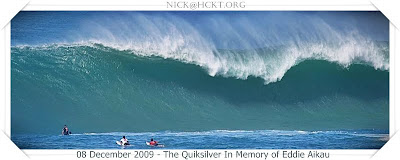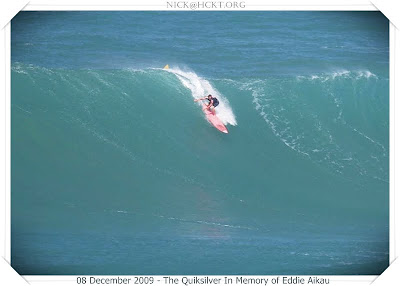 Photo by Hugh Gentry/Reuters
Photo by Hugh Gentry/ReutersDecember 8, 2009
As Hawaii’s Seas Roil, Surfers Await the Big One
By Jesse McKinley for the New York Times
WAIMEA BAY, Hawaii — The world’s best surfers are waiting for a once-in-a-generation wave here along the North Shore of Oahu, after dozens of them plunged into the churning waters on Monday, dodging rocks, reefs, and driftwood in waves rarely seen even in surf paradises like Hawaii — but still shy of the big one.
Not that it wasn’t dangerous, with crushing, rolling, manhandling waves able to break boards and bodies alike. Lifeguards talked one surfer through a nasty wipeout early Monday, and used all-terrain vehicles to reach another who had shattered an ankle.
“I’m stoked,” said Greg Long, 26, a surfer from Southern California. “If it happens,” he said of the predicted swell, “it’s going to be the most exciting big-wave event in the history of the sport.”

Surf experts and weather officials have forecast a swell — churned by North Pacific storms — that may rival those of 1969, considered a seminal year in surfing the North Shore, where images of surfers flying down towering waves helped bring the sport into the mainstream and into the perennial realm of cool.
In the next day or so, 30-foot to 50-foot wave faces are possible, according to the National Weather Service, the type of prediction that sends professional wave-riders into an extremely mellow frenzy.
“I chase big waves around the world to foggy places where it’s freezing cold,” said Mark Healey, 28, a professional surfer who grew up on the North Shore. “To finally get a swell like this in my backyard, there’s no way I’m missing a second of it.”

Before dawn on Monday, the cream — or is it the foam? — of the surfing world assembled at Waimea Bay on the possibility that the Quiksilver in Memory of Eddie Aikau Competition — one of the sport’s most prestigious and rarest events — would be held. “The Eddie,” named for a well-known Hawaiian surfer and lifeguard, is an invitation-only event held when the surf is at its fiercest — in its 25-year history, it has been held only seven times, the last in 2004 — and can be called at a moment’s notice.
So it is that over the last week, all 28 invited surfers and most of the 24 alternates have flown in, shipped in extra boards, and nervously watched the radar and buoy reports for signs that “Eddie-approved” waves would arrive.

On Monday morning, the surf was big enough but too rowdy for smooth surfing, though organizers had high hopes for Tuesday. “Welcome to the Thunderdome,” said Mark Cunningham, one the event’s announcers, to thousands of spectators. “Here comes another set!”
Onlookers filled the wide beach, throwing down towels and pitching tents in the wet sand, while others stood at attention, cheering and “oohing” as surfers curled into cylinders of water, shooting out and occasionally into acres of white foam.

“Even the pros know it’s sketchy,” said Cameron Motz, a spectator. “Or they’re crazy.”
Competitors used the day for practice as the surf built. By late afternoon, some people were riding 30-foot waves in the bay, while at nearby Sunset Beach a crew was using a crane to move a lifeguard station out of the way of oncoming surf.
At Waimea, lifeguards had to continually warn spectators — and lesser surfers — from going too close to the water.
“Anybody who enters the water today,” a lifeguard, Jeff Morelock, said over a beachside public-address system, “better know what they are doing.”
Dozens of relatives of Mr. Aikau, who vanished — atop his board — in 1978 while trying to rescue passengers on a capsized canoe off the Hawaiian coast, had also traveled to the bay where Mr. Aikau’s prowess as a lifeguard is the stuff of lore.

Officials closed beaches all along the shore in expectation of the big surf, and the police and civil defense officers were warily monitoring the coast for flooding, as some residents moved possessions to higher ground.
A predicted three-part swell began developing on Friday night, drawing both professionals and recreational surfers to the wide sand beaches and surfing meccas like the Pipeline and ocean spots with names like Avalanche.

Bill Weeshoff, who works in advertising in Honolulu, dared the North Shore waves on Sunday even as newly stretched police tape warned beachcombers not to enter the water. Mr. Weeshoff, who moved to Hawaii 16 years ago to surf and never left, called the conditions “epic.”
“This,” he said, “is why you live in Hawaii.”
The big waves were also a boon for local businesses, as hotels and surf shops filled up. Joe Green, the owner of Surf N’ Sea, in nearby Haleiwa, said that winter tourism — a lifeblood of the Hawaiian economy — seemed to be coming back in 2009, and that big surf helped.
“People need more equipment,” Mr. Green said. “And break more equipment.”

The storm in the Pacific had also raised hopes for another major surfing event — the Mavericks — held outside Half Moon Bay, Calif., near San Francisco, with some of the same surfers.
“I’d finish here, and get the red eye,” said Peter Mel, a veteran surfer from Santa Cruz, near Half Moon Bay. “It would be the ultimate swell.”
On Monday, however, organizers said the Mavericks probably would not place this week.
Whether Hawaii would be witness to the Eddie any time soon remained an open question, though the event’s 79-year-old director, George Downing, said that his sense of the weather and wave reports made Tuesday a real possibility. A lifelong big-wave surfer with the laid-back attitude to match, Mr. Downing checked hourly reports from a buoy 200 miles northwest of the islands and seemed to believe that the big surf was on its way.

“If it’s going to come,” he said, surveying the surf at daybreak on Monday, “it’s going to come tomorrow.”






